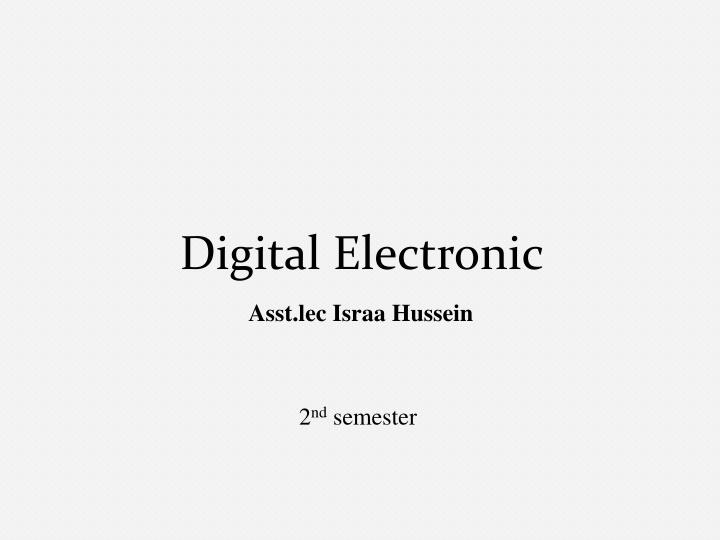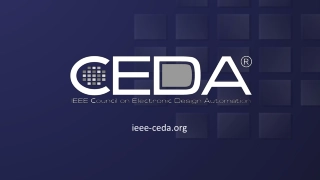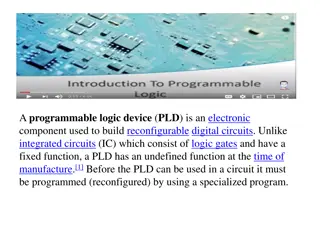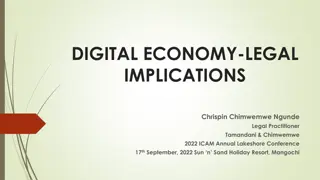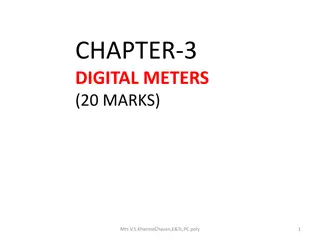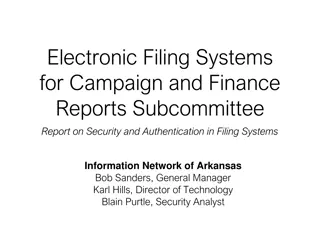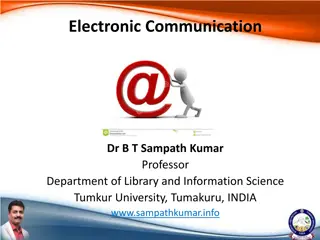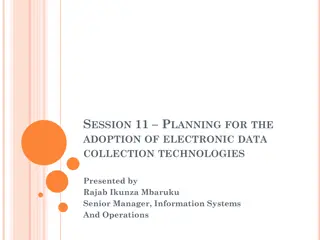Digital Electronic
Israa Hussein's 2nd semester lecture on digital electronic systems explores the comparison between binary and decimal numeration systems. Delve into the representation of quantities in binary, the ease of materializing 0 and 1 in electronics, and the binary equivalent of numbers like 35. Understand the significance of binary in computer sciences and learn about representing quantities efficiently in digital circuits. Explore practical examples, formulas, and the conversion process from binary to decimal.
Download Presentation

Please find below an Image/Link to download the presentation.
The content on the website is provided AS IS for your information and personal use only. It may not be sold, licensed, or shared on other websites without obtaining consent from the author.If you encounter any issues during the download, it is possible that the publisher has removed the file from their server.
You are allowed to download the files provided on this website for personal or commercial use, subject to the condition that they are used lawfully. All files are the property of their respective owners.
The content on the website is provided AS IS for your information and personal use only. It may not be sold, licensed, or shared on other websites without obtaining consent from the author.
E N D
Presentation Transcript
Digital Electronic Asst.lec Israa Hussein 2ndsemester
Chapter One Lecture 2 2
Binary versus decimal numeration system: Let us count from 0 to 15 using binary and decimal systems of numeration 3
Binary Decimal D(MSB) C B A(LSB) 0 0 0 0 0 0 0 0 0 0 0 0 0 0 0 0 1 1 1 1 0 0 0 0 1 1 0 0 2 2 0 0 0 0 1 1 1 1 3 3 0 0 1 1 0 0 0 0 4 4 0 0 1 1 0 0 1 1 5 5 0 0 1 1 1 1 0 0 6 6 0 0 1 1 1 1 1 1 7 7 1 1 0 0 0 0 0 0 8 8 1 1 0 0 0 0 1 1 9 9 1 1 0 0 1 1 0 0 10 10 1 1 0 0 1 1 1 1 11 11 1 1 1 1 0 0 0 0 12 12 1 1 1 1 0 0 1 1 13 13 1 1 1 1 1 1 1 1 1 1 1 1 0 0 1 1 14 14 15 15 4
The representation of a quantity in the binary numeration system takes more ciphers than in the decimal system. We can therefore ask ourselves why the binary system is preferred to the decimal system in computer sciences. The reason is that in electronics, it is easier to materialize two quantities 0 and 1 (by two different voltages, for example) than to materialize 0 , 1 , 2 , 3 , 4 , 5 , 6 , 7 , 8 , and 9 (by 10 different voltages). 10 different quantities In fact, in digital circuits, 0 and 1 are materialized by specific ranges of voltages or current; this will be discussed later. 5
Find the binary equivalent of number 35 LSD LSD Dividers Dividers Remainder Remainder 35 35 2 2 1 1 17 17 2 2 1 1 Remainder Remainder 8 8 2 2 0 0 4 4 2 2 0 0 2 2 2 2 0 0 1 1 2 2 1 1 MSD MSD 0 0 Therefor, the binary equivalent of number 35 = 100011 7
Remark 1.1: With n bits, we can represent 2ndifferent binary numbers. The higher H number is given using the following formula. 9
Example 1.4: With 4 bits we can represent Different binary numbers (from 0 to 15), And the higher number is 10
Remark 1.2: Conversion from binary to decimal To convert a number written in a binary numeration system to its equivalent in decimal, We just have to calculate the products of the bits with their respective weights, as in example 1.3 above. For binary numbers with binary point (the equivalent of the decimal point for decimal numbers), the conversion is done as follows. 11
1.3.4 Octal numeration system: The octal numeration system is a place weighted system with a base of eight. Valid ciphers include the symbols 0 , 1 , 2 , 3 , 4 , 5 , 6 , and 7 . To convert from binary to octal numeration system, we just have to divide the number into groups of binary numbers having 3 bits each. And each group of 3 bits is replaced by its equivalent in octal. 13
Example 1.5: Let s convert the following binary numbers in octal: A = 10110101 B = 11010111.01 15
Example 1.5: The bits are grouped from the right to the left. A zero has been added to the two firs bits to form a group of 3 bits. That zero is called an implied zero. 16
Example 1.5: The bits are grouped from the right to the left. A zero has been added to the two firs bits to form a group of 3 bits. That zero is called an implied zero. Two implied zeros have been added to the number to form groups of 3 bits. 17
Exercise 1.2: Convert the following binary numbers to decimal numbers: om to the Octal number. A = 10110.01 B = 11110111.1011 C = 111.111 D = 10110101101.111101 Watch the videos https://www.youtube.com/watch?v=OezK_zTyvAQ https://www.youtube.com/watch?v=bmgZf4VMhHc 18
